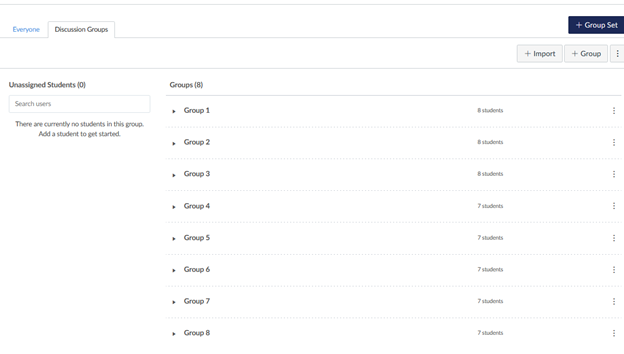
Discussions in asynchronous online courses provide an opportunity for students to share their thoughts and learn from classmates in a fashion emulating in-class discussions. This allows students to contribute their thoughts and take time to respond to classmates’ comments. In a large enrollment online course, dividing the class into groups provides the opportunity for students to achieve greater social presence and further enhance their understanding of discussion topics (Akcaoglu & Lee, 2016). Social presence encompasses student perceptions of each other’s responsiveness and group cohesion (Sung & Mayer, 2012). Social presence also contributes to student motivation and participation, actual and perceived learning, course and instructor satisfaction, and retention in online courses (Richardson, Maeda, Lv & Caskurlu, 2017). Along these lines, group discussions also enhance collaboration and improve the quality of group work.
Much like Woods and Bliss (2016), we recommend using group discussions, providing clear expectations for those discussions, and offering instructor feedback, as means of increasing social presence and enhancing participation in large enrollment courses. In particular, the use of a self-assessment rubric guides students to improve their contributions to the dialogue over the course of the semester.
Link to example artifact(s)
- Course Title: NURSP 2099 Financial, Business, and Economic Drivers in Healthcare Management
- Instructor: Judith F. Zedreck-Gonzalez, DNP, MPM, NEA-BC
In an asynchronous graduate nursing course, the class was divided into small groups for meaningful interactive discussions. The smaller number of students in each group meant that it was more likely students would interact with each other multiple times, building social presence that has been shown to enhance perceived learning and student satisfaction (Richardson et al., 2017). While research identifies 4-5 students as the ideal size for group discussions (Aloni & Harrington, 2018), these graduate nursing groups featured 7-8 students because these were also groups for the final group project (Figure 1).

By maintaining these groups throughout the semester, and collectively progressing towards a final task, on which the group would all receive the same grade, we further increased motivation, and the quality of participation in these asynchronous online group discussions. As early as Rovai (2003), student participation, measured in number of posts, increased when discussions accounted for either 10-20% or 25-35% of the final semester grade. In our course, these small group discussions were worth 20% of the final grade, ultimately building towards a final project worth an additional 30% and a final presentation worth 15% of the final semester grade. By presenting the discussion expectations clearly (Wyss, Freedman & Siebert, 2014) in the syllabus, we were able to ensure a higher quality of contribution throughout the semester.
Maintaining active group discussions can be challenging, as it requires a consistent level of interaction between all participants. Building a successful asynchronous discussion requires not only an initial post to define a topic, but a healthy balance of follow-up responses to solidify learning concepts. We addressed these challenges by requiring students to contribute an initial post and two follow-up posts to classmates, which helped ensure participation and interaction in the discussion. Much like (Woods & Bliss, 2016) two separate deadlines for the initial posts and the replies encouraged student-student interaction.
Module 3 Discussion Prompt
Reflect on the 10 Key Economics Concepts presented in the lecture, select two concepts and describe how they are being impacted by the global COVID pandemic.
Please post your initial response by Wednesday at 11:59PM. Read and respond to two of your peers by Sunday at 11:59PM. In particular, note how your observations are the same or different than your peers.
Module 8 Discussion Prompt
Causes of internal variances include: Shifts on quality of care, changes in technology, efficiency of nurses, changes in policy, incorrect standards, and poor planning. Give an example in your clinical practice where one of these elements resulted in a budget variance. Could any action have been taken to avoid the variance?
Please post your initial response by Wednesday at 11:59PM. Read and respond to two of your peers by Sunday at 11:59PM.
Further motivation came from the self-evaluation rubric of discussion posts that students submitted at the end of the semester. This self-assessment includes references to specific posts to be reviewed and graded by the instructor and requires students to justify their scores with evidence from their posts. The rubric contains categories requiring multiple posts, considering frequency, content contribution, references and mechanics. In addition, the students are required to identify 3 posts that are factually correct, reflective and substantive contributions to these group discussions. This requirement, presented at the beginning of the semester, motivates students to contribute thoughtfully to the discussions over the course of the semester.
After every discussion, the instructor summarized the most important details from the week’s group discussions so that all groups could learn from each other. This increased instructor-student interaction, showing students that all discussions are being read and evaluated, and encouraging critical thinking. Research shows that students in the group with no instructor posting during the week exhibited more open communication than students in groups where the instructor responded to every student’s initial posting (An, Shin & Lim, 2009). This method also takes instructor burden into account, which is particularly important with a large enrollment class.
Students responded on the course evaluations that they benefited from “summarizing effective discussions” and the weekly update emails identifying “key terms… that helped us understand more about the topic”. Students “really appreciated the ‘Take Away’ announcements…. She was attentive to our discussions and brought the meaning forward.” Another student remarked that the instructor “Stimulate[d] thinking through discussion posts”. Overall, the instructor facilitated a positive learning experience by using groups to form smaller discussions for a large-enrollment class.
Link to scholarly reference(s)
Akcaoglu, M., & Lee, E. (2016). Increasing social presence in online learning through small group discussions. The International Review of Research in Open and Distributed Learning, 17(3).
Aloni, M., & Harrington, C. (2018). Research based practices for improving the effectiveness of asynchronous online discussion boards. Scholarship of Teaching and Learning in Psychology, 4(4), 271.
An, H., Shin, S., & Lim, K. (2009). The effects of different instructor facilitation approaches on students’ interactions during asynchronous online discussions. Computers & Education, 53(3), 749-760.
Richardson, J. C., Maeda, Y., Lv, J., & Caskurlu, S. (2017). Social presence in relation to students’ satisfaction and learning in the online environment: A meta-analysis. Computers in Human Behavior, 71, 402-417. DOI:https://doi.org/10.1016/j.chb.2017.02.001
Rovai, A. P. (2003). Strategies for grading online discussions: Effects on discussions and classroom community in Internet-based university courses. Journal of Computing in Higher Education, 15(1), 89−107.
Sung, E., & Mayer, R. E. (2012). Five facets of social presence in online distance education. Computers in Human Behavior, 28(5), 1738-1747.
Woods, K., & Bliss, K. (2016). Facilitating Successful Online Discussions. Journal of Effective Teaching, 16(2), 76-92.
Wyss, V. L., Freedman, D., & Siebert, C. J. (2014). The development of a discussion rubric for online courses: Standardizing expectations of graduate students in online scholarly discussions. TechTrends, 58(2), 99-107.
Citation
Drozd, A,M., Zedreck-Gonzalez, J.F. & Frey, B. (2021). Use self-evaluation and instructor feedback in group discussions to enhance participation in large-enrollment courses. In A. deNoyelles, A. Albrecht, S. Bauer, & S. Wyatt (Eds.), Teaching Online Pedagogical Repository. Orlando, FL: University of Central Florida Center for Distributed Learning. https://topr.online.ucf.edu/use-self-evaluation-and-instructor-feedback-in-group-discussions-to-enhance-participation-in-large-enrollment-courses/.